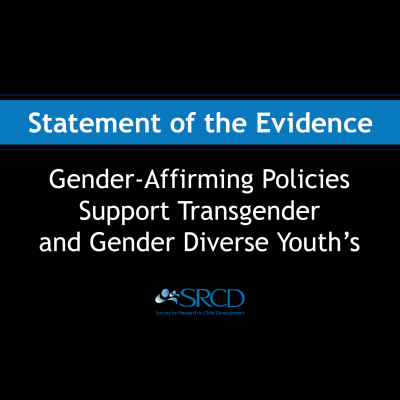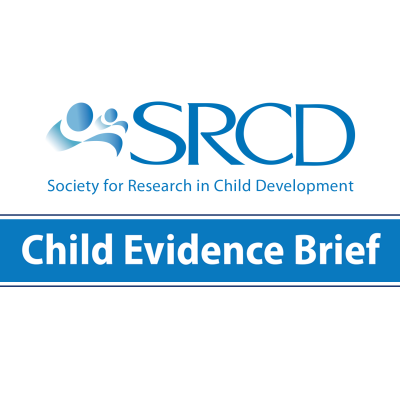The Science is Clear: Separating Families has Long-term Damaging Psychological and Health Consequences for Children, Families, and Communities
Written by*
- Johayra Bouza, University of Miami
- Daisy E. Camacho-Thompson, Ph.D., Reach Institute & Arizona State University
- Gustavo Carlo, Ph.D., University of Missouri
- Ximena Franco, Ph.D., Frank Porter Graham Development Institute & University of North Carolina-Chapel Hill
- Cynthia García Coll, Ph.D., Albizu University
- Linda C. Halgunseth, Ph.D., University of Connecticut
- Amy Marks, Ph.D., Suffolk University
- Gabriela Livas Stein, Ph.D., University of North Carolina-Greensboro
- Carola Suárez-Orozco, Ph.D., University of California, Los Angeles
- Rebecca M. B. White, Ph.D., Arizona State University
* Authors are listed in alphabetical order
After the United States Department of Justice announced the “Zero Tolerance Policy for Criminal Illegal Entry,” Immigration and Custom Enforcement (ICE — an arm of the Department of Homeland Security) separated approximately 2,000 children from their parents in April and May 2018 as they approached the U.S. border. Children and parents were placed in separate facilities as they were being processed and were not told when or how they would be reunited. This policy and its consequences have raised significant concerns among researchers, child welfare advocates, policy makers, and the public, given the overwhelming scientific evidence that separation between children and parents, except in cases where there is evidence of maltreatment, is harmful to the development of children, families, and communities. Family separations occurring in the presence of other stressors, such as detention or natural disaster, only adds to their negative effects.
Evidence on Harmful Effects of Parent-Child Separation
The evidence that family separation is harmful dates back to studies on the effects of parent-child separations on children’s well-being during World War II. This research documented far reaching effects of these separations into adulthood, including increased risk for mental health problems, poor social functioning, insecure attachment, disrupted stress reactivity, and mortality (Pesonen & Räikkönen, 2012; Rusby & Tasker, 2009; Mitrani, Santisteban, & Muir, 2004). Other research similarly documents the harmful effects of parental separation on child well-being in a variety of other child populations including children in Romanian orphanages (Zeanah, Nelson, Fox, et al., 2003), children in foster care (Flannery, Beauchamp, & Fisher, 2017) and children of incarcerated parents (Geller, Garfinkel, Cooper & Mincy, 2009; Miller, 2006). More recent work has documented the increased mental health risk faced by both parents and children when they are separated in the immigration process (Suarez-Orozco, Bang, & Kim., 2011; Rusch & Reyes, 2013). Parent-child separation has long-term effects on child well-being, even if there is subsequent reunification. After being separated, reunited children can experience difficulty with emotional attachment to their parents, self-esteem, and physical and psychological health (Smith, Lalonde, & Johnson, 2004; Gubernskaya & Debry, 2017). For some children, time does not appear to fully heal these psychological wounds (Shonkoff et al., 2012).
Parents Buffer Children from Adverse Effects of Toxic Stress
Parental separation is considered a toxic stressor, an experience that engages strong and prolonged activation of the body’s stress-management system (Bridgman, 2014). The physiological and psychological toll of early life stress, including parental separation, changes how the body responds to stress in the long term, disrupting higher-order cognitive and affective processes as well as negatively altering brain structures and functioning (Lupien, McEwen, Gunnar, & Heim, 2009; Pechtel & Pizzagalli, 2011; Kumar et al., 2014). Such stressors put children at greater risk for a multitude of health and psychological impairments, including anxiety, depression, post-traumatic stress disorder, lower IQ, obesity, immune system functioning, physical growth, cancer, heart and lung disease, stroke, and morbidity (Granqvist, Sroufe, Dozier, Hesse, & Steele, 2017; Heim & Nemeroff, 2001; Maniam, Antoniadis, & Morris, 2014; Pechtel & Pizzagalli, 2011; Shirtcliff, Coe, & Pollak, 2009; Taylor, 2010).
Children depend on their primary caretakers to successfully navigate stressful and traumatic events. Children’s physiological responses to stress can be significantly reduced by access to their primary caretaker (Hostinar, Sullivan, & Gunnar, 2013). The separation of the family unit under extreme conditions of stress worsens the psychological and physiological ramifications of that stressor on children, especially younger children (Masten & Narayan, 2012). Conversely, ongoing contact with primary caregivers under conditions of stress can protect against risk (Rodriguez & Margolin, 2015).
Child-Separation from Parents Impacts Children at All Ages
Much of the research on family separation has focused on the impacts on children early in development. However, puberty is also an especially vulnerable time of rapid change (Doom & Gunnar, 2013). Stressors during adolescence can have lasting impacts — the effects of which may not become evident until adulthood — (Humphreys, Gleason, Drury, et al., 2015; Lupien, McEwen, Gunnar, & Heim, 2009). Further, the effects of traumatic experiences are cumulative; children and adolescents who have already faced previous adversity are particularly susceptible to long term further negative consequences (Brown, Anda, & Tiemeier, et al, 2009; MacKenzie, Bosk, & Zeanah, 2017). Thus, the research shows that across infancy, childhood, and adolescence, child-family separations can be related to negative outcomes across the lifespan.
Impact of Border Family Separations on U.S. Citizens
There is also evidence that family separations harm U.S. citizens whose family members experience border detention or deportation. Parental separation increases the risk for these U.S. children’s mental health problems such as anxiety, depression, behavior problems, and symptoms of post-traumatic stress disorder (Allen, Cisneros, & Tellez, 2015; Rojas-Flores, Clements, Hwang Koo, & London, 2017; Zayas, Aguilar-Gaxiola, Yoon, & Rey, 2015). U.S. citizens of Latino descent also report heightened worries and concerns for their families and their communities as a result of changes in implementation of immigration policies such as the Deferred Action for Childhood Arrivals (DACA) policy (Roche, Vaquera, White, & Rivera, 2018). Moreover, countries with supportive integration policies are more likely to have child populations with better overall health and mental health indicators than those with less supportive approaches (Marks, McKenna, & Garcia Coll, 2018). Thus, there is evidence that policies about parental separations can negatively affect American citizens.
The Policy Implications are Clear
The scientific evidence is conclusive. Parent-child separations lead to a host of long-term psychological, social, and health problems that are not necessarily resolved upon reunification. In particular, the disruption of biological stress regulation mechanisms in the body induced by the need to seek refugee or asylum status are further taxed by the absence of parental support. The science is clear: policies that separate immigrant families upon entry to the U.S. have devastating and long-term developmental consequences for children and their families.
We thank the SRCD Latino Caucus for their contributions.
Endnotes / References
Allen, B., Cisneros, E. M., & Tellez, A. (2015). The children left behind: The impact of parental deportation on mental health. Journal of Child and Family Studies, 24(2), 386-392. doi:10.1007/s10826-013-9848-5
Bridgman, A. (2014). How abuse and neglect affect children’s minds and bodies. Social Policy Report Brief, 28(1).
Brown, D. W., Anda, R. F., Tiemeier, H., Felitti, V. J., Edwards, V. J., Croft, J. B., & Giles, W. H. (2009). Adverse Childhood Experiences and the Risk of Premature Mortality. American Journal of Preventive Medicine, 37(5), 389-396. https://doi.org/10.1016/j.amepre.2009.06.021
Doom, J. R., & Gunnar, M. R. (2013). Stress physiology and developmental psychopathology: Past, present, and future. Development and Psychopathology, 25(4), 1359-1373. doi:10.1017/S0954579413000667
Gubernskaya, Z., & Debry, J. (2017). US Immigration Policy and the case for family unity.
Journal on Migration and Human Security, 5(2) 417-430. doi:10.14240/jmhs.v5i2.91
Heim, C., & Nemeroff, C. B. (2001). The role of childhood trauma in the neurobiology of mood and anxiety disorders: Preclinical and clinical studies. Biological Psychiatry, 49(12), 1023-1039. doi:10.1016/S0006-3223(01)01157-X
Hostinar, C. E., Sullivan, R. M., & Gunnar, M. R. (2014). Psychobiological mechanisms underlying the social buffering of the hypothalamic–pituitary–adrenocortical axis: A review of animal models and human studies across development. Psychological Bulletin, 140(1), 256-282. doi:10.1037/a0032671
Kumar, A., Behen, M. E., Singsoonsud, P., Veenstra, A. L., Wolfe-Christensen, C., Helder, E., & Chugani, H. T. (2014). Microstructural abnormalities in language and limbic pathways in orphanage-reared children: A diffusion tensor imaging study. Journal of Child Neurology, 29(3), 318-325. doi:10.1177/0883073812474098
Lupien, S. J., McEwen, B. S., Gunnar, M. R., & Heim, C. (2009). Effects of stress throughout the lifespan on the brain, behaviour and cognition. Nature Reviews Neuroscience, 10(6), 434-445. doi:10.1038/nrn2639
MacKenzie, M. J., Bosk, E., & Zeanah, C. H. (2017). Separating Families at the Border—Consequences for Children’s Health and Well-Being. New England Journal of Medicine, 376(24), 2314-2315. https://doi.org/10.1056/NEJMp1703375
Maniam, J., Antoniadis, C., & Morris, M. J. (2014). Early-life stress, HPA axis adaptation, and mechanisms contributing to later health outcomes. Frontiers in Endocrinology, 5(MAY), 73. doi:10.3389/fendo.2014.00073
Marks, A. K., McKenna, J. L., & Garcia Coll, C. (2018). National immigration receiving contexts: A critical aspect of native-born, immigrant, and refugee youth well-being. European Psychologist, 23(1), 6-20. doi:10.1027/1016-9040/a000311
Masten, A. S., & Narayan, A. J. (2012). Child development in the context of disaster, war, and terrorism: Pathways of risk and resilience. Annual Review of Psychology, 63(1), 227-257. doi:10.1146/annurev-psych-120710-100356
Pechtel, P., & Pizzagalli, D. A. (2011). Effects of early life stress on cognitive and affective function: An integrated review of human literature. Psychopharmacology, 214(1), 55-70. doi:10.1007/s00213-010-2009-2
Pesonen, A., & Räikkönen, K. (2011;2012;). The lifespan consequences of early life stress. Physiology & Behavior, 106(5), 722-727. doi:10.1016/j.physbeh.2011.10.030
Roche, K., Vaquera, E., White, R. M. B., & Rivera, M. I. (2018). Impacts of Immigration Actions and News and the Psychological Distress of U.S. Latino parents raising adolescents. Journal of Adolescent Health, 62, 525 – 531. doi: 10.1016/j.jadohealth.2018.01.004
Rodriguez, A. J., & Margolin, G. (2015). Parental incarceration, transnational migration, and military deployment: Family process mechanisms of youth adjustment to temporary parent absence. Clinical Child and Family Psychology Review, 18(1), 24-49. doi:10.1007/s10567-014-0176-0
Rojas-Flores, L., Clements, M., Koo, J., & London, J. (2017). Trauma and psychological distress in latino citizen children following parental detention and deportation. Psychological Trauma-Theory Research Practice and Policy, 9(3), 352-361. doi:10.1037/tra0000177
Rusby, J. S. M., & Tasker, F. (2009). Long-term effects of the british evacuation of children during world war 2 on their adult mental health. Aging & Mental Health, 13(3), 391-404. doi:10.1080/13607860902867750
Rusch, D., & Reyes, K. (2013). Examining the effects of mexican serial migration and family separations on acculturative stress, depression, and family functioning. Hispanic Journal of Behavioral Sciences, 35(2), 139-158. doi:10.1177/0739986312467292
Shonkoff, J. P., Garner, A. S., The Committee on Psychosocial Aspects of Child and Family Health, Committee on Early Childhood, Adoption, and Dependent Care, and Section on Developmental and Behavioral Pediatrics, Siegel, B. S., Dobbins, M. I., Earls, M. F., Garner, McGuinn, L., Pascoe, J., & Wood, D. L. (2012). The lifelong effects of early childhood adversity and toxic stress. Pediatrics, 129 (1), e232-246. doi: 10.1542/peds.2011-2663
Smith, A., Lalonde, R. N., & Johnson, S. (2004). Serial migration and its implications for the parent-child relationship: A retrospective analysis of the experiences of the children of caribbean immigrants. Cultural Diversity and Ethnic Minority Psychology, 10(2), 107-122. doi:10.1037/1099-9809.10.2.107
Suárez-Orozco, C., Bang, H. J., & Kim, H. Y. (2011). I felt like my heart was staying behind: Psychological implications of family separations & reunifications for immigrant youth. Journal of Adolescent Research, 26(2), 222-257. doi:10.1177/0743558410376830
Taylor, G. J. (2010). Affects, trauma, and mechanisms of symptom formation: A tribute to john C. nemiah, MD (1918–2009). Psychotherapy and Psychosomatics, 79(6), 339-349. doi:10.1159/000320119
Zayas, L. H., Aguilar-Gaxiola, S., Yoon, H., & Rey, G. N. (2015). The distress of citizen-children with detained and deported parents. Journal of Child and Family Studies, 24(11), 3213-3223. doi:10.1007/s10826-015-0124-8


